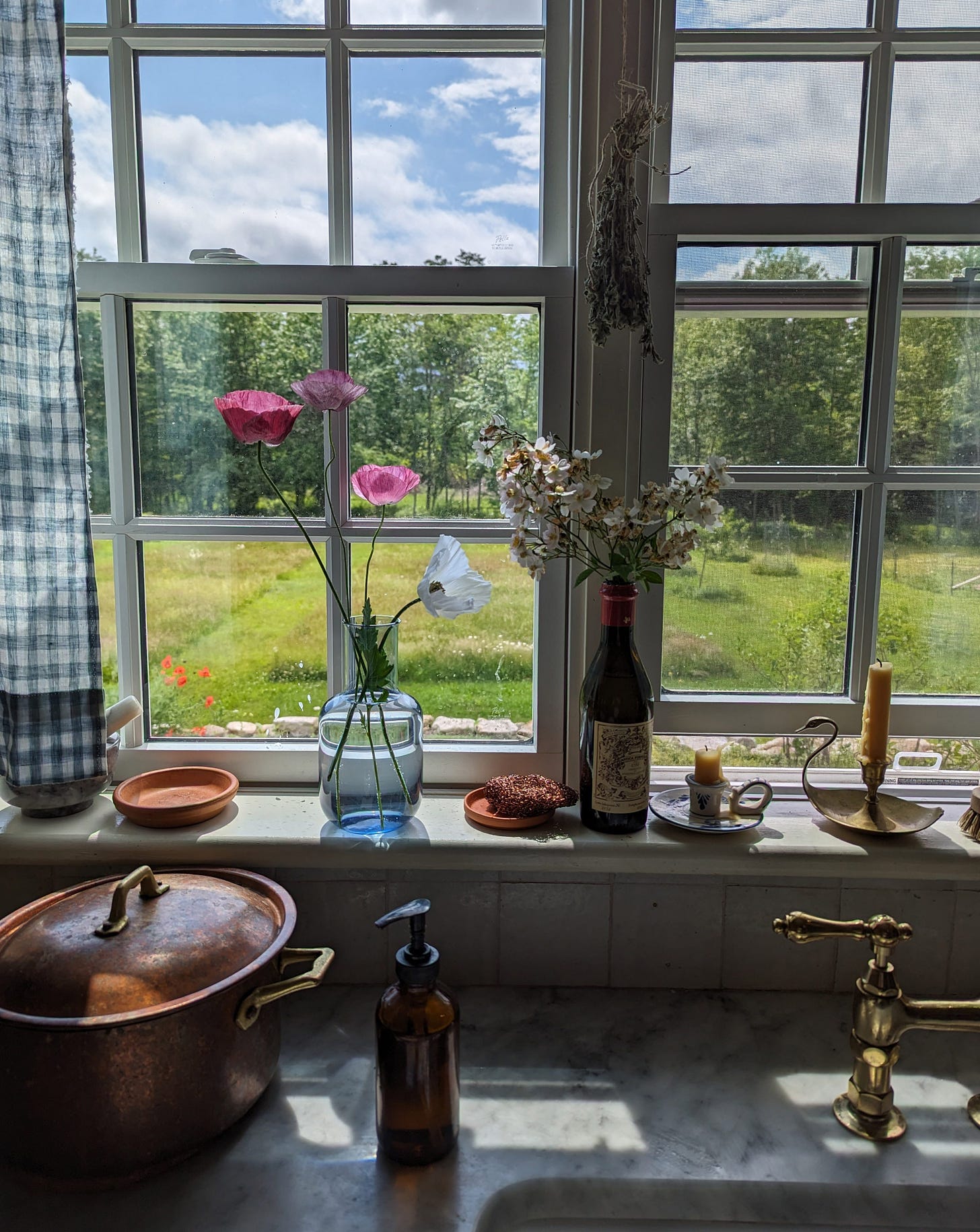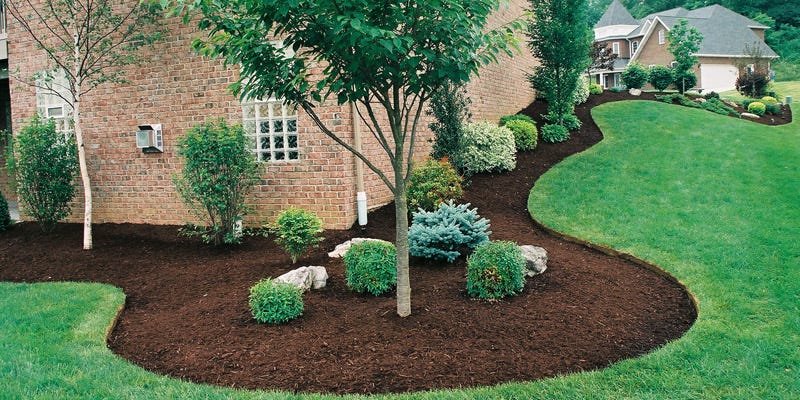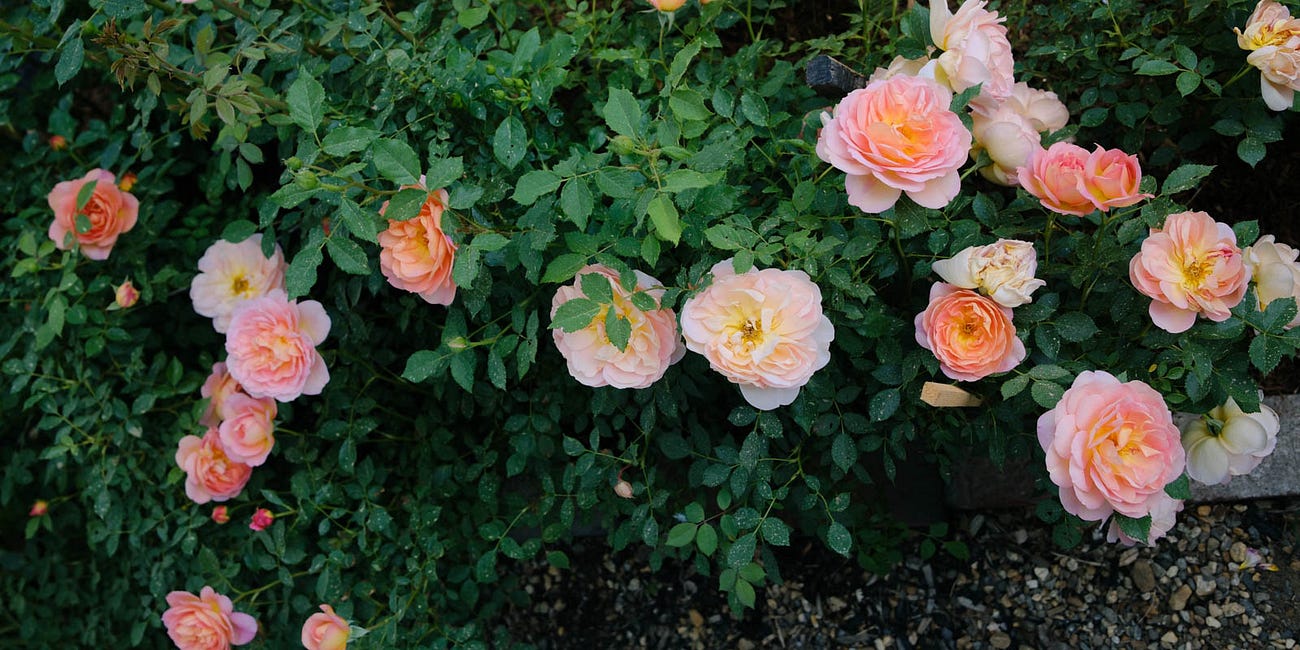I have been sharing pictures of flowers growing around my house, mostly little things like poppies and roses, or my fields, and several people have asked me to write about gardening, or for gardening advice. But this request encounters a ridiculous shortcoming: I know almost nothing about gardening!
I have for years mostly experimented haphazardly. Sometimes this results in very nice appearances, which get photographed, but often it doesn’t. I think project failures sometimes warrant showing also but even my failures have been too bland to report. My experimentation has lead to a large amount of doing and then undoing, and the “undo” is much more labor in the physical world than on a screen. I do it all the same. Part of what I admire about ornamental gardening is that exceptional gardens require a certain amount of labor. I do not have immense resources, but I do have that. Of course that labor isn’t usually moving blueberries and hydrangeas and large stones around like a madman. I will get there.
But I have spent, in some years, $300 on various poppy seeds alone, only to see them vanish into the ground. I have spent the same the next year, after tilling first, only to see a scant few come up (though other flowers covered for them, that year). I have discovered many things through such dubiously effective trial and error. In this case, the front field needed lime. Also that consistent irrigation is not optional for seedlings when drought persists.
My preferred way of creating things is to learn by doing, but it does have drawbacks. With gardening, besides digging up a lot of plants to move them, an experimental mentality includes an inherent hesitation to make big moves. This can be acceptable as a way to bide time and think through what one really wants. But eventually one wants to increase the intensity.
It is only this year that a clear idea has come to me for an ornamental setup. It will primarily be a rose garden, with a few other messy beds for herbs and bunches of things. The farther from the house will still be wild in every direction, though I intend to plant drifts of a few bulbs. This fall and winter I’ll spend considerable time planning and reading more (and planting the two thousand bulbs I ordered1).
Despite my failures so-far, and not much yet that’s showy, my thinking for what will make a good garden has coalesced around a few uncomplicated principles. Here they are.
Grow what you would like to cut and take inside
The joy of a garden comes from the use of it, inside and out, ornamental and culinary. The first thing we planted was a small herb garden up the hill, where we can quickly run out at breakfast to fetch things like chives for scrambled eggs. In the midst of a dozen experiments, this has been a success since day one.
When thinking about what to plant, consider foremost what you’d want to harvest. This is a good way to make use of even a tiny garden. And this means not just singular flowers but whole branches of crabapple blossoms, sage and catmint blossoms with their foliage, lilacs, wild roses, etc.
One of the reasons I am moving towards roses is that I desire them so much indoors. They are a visceral delight at every distance.
Mow less
Keep big sections untouched for month or two at a time if you can. This lets you experiment with shaping, and using your land in different ways. It’s also less work, and more resilient under drought conditions.
There is an aliveness to fields that lawns do not have. Our small patio on a hill overlooks the tall grasses, which attract many birds and dance in the wind. Paths through fields are a simple way to capture a slight feeling of enclosure, you go from walking over the land to walking through the land.
“If you have just so much money, spend it all on one variety and make a big splash.”
Tasha Tudor said this. I believe it with my whole heart, for more than just gardening. This doesn’t mean you cannot start small or experiment, but if you are, once you have something that feels like it is really working, you should press into it with emphasis.
Bad gardens are often about insensitivity to context
A garden is not made magical by plants alone, but by its ability to generate moods and feelings, such as those of bounty and enclosure. This is partly why much modernist gardening (or “landscaping”)—that spaces a few plants apart in a bed of mulch, almost to show off the mulch as much as the plants—falls flat.
Two house corners follow, clearly not comparable, but its worth thinking of the decisions involved that make them so incomparable:
This looks as it does not because anyone thinks it is pretty (I hope), and not because its maintenance free, but because the design allows for low-context maintenance. The ocean of mulch is not designed for the viewer, but for the maintainer, so he can see it better. Among the sea of mulch and harsh edging, anyone can understand what needs to be done to make it look “correct”. Pull the weeds that are not the little shrubs. Cut grass along the curve. Mow. Spray. Done. The focus is not on vegetation fitting in, but making sure vegetation is easy to remove. It less resembles a garden than a perpetual horticultural demolition site. There are no cuttings to take here, and no strolling through.
With only sparse shrubs, anyone can come in and weed and mulch it without needing to understand the slightest thing. One’s lawn service company or personnel could change weekly and it could still be kept up easily. But if you want something really beautiful, you need to have someone willing to learn the patterns of your garden, or you need to do it yourself.
This is quite a bit different on the effort scale, but its worth considering what makes this house corner prettier, and with less need of mulch or edging. Instead there are high context decisions: When do you prune the roses? How do you shape the hedges? And in the thicker beds on the right, you need to know, each year, what is a weed and what will become a desirable flower. While not comparable in ease it is worth pointing out just what tasks that the modern landscaper has explicitly unburdened from himself. And then ask yourself: Do you really want to make these tradeoffs?
The first image can be maintained by anyone (or any landscaping company staffed by anyone). To maintain the second image, one must cultivate a sensitivity to context, in order to know what will work. The gardening can then focus on fitting in, instead of removing. This scene does not necessitate a master gardener to keep. It requires only time and attention, the same ingredients that create any intimacy. It would, in hands such as mine which are full of other tasks, also be a weedier place. In may not be as prim as a perfect garden, but even so it will have all the signs of bursting with life.
I want to make something living.
~ ~ ~
I will keep a record of my grand rose garden experiments. I cannot write what I know, as the phrase goes, but I can write what I’m learning. This year as I said is mostly planning.
I hope to write again very soon, about the act of reading. Until then,
s s
~ ~ ~
Update, see:
Why make something beautiful?
To be happy at home is the ultimate result of all ambition, the end to which every enterprise and labour tends, and of which every desire prompts the prosecution.
If you want to see more pictures of my gardens today, there are some on instagram and twitter.
200 Chionodoxa
100 Irises
1000 Bakeri (species) tulips
100 Mount Tacoma tulips
600 Daffodils
This totals $700.98 (shipping included) at Van Engelen, a wholesale bulb supplier.
The field tulips may get heavily eaten by deer. But I have to try.








I am reminded of "Bunny" Mellon of Oak Spring Garden in Virginia, saying
"Gardens like many beautiful things one thinks will never change – never cease to be what they are, never die – they follow the cycle of all living things, never remaining the same. Take notes to help remind those in later years of all they possessed so that they may imagine dreams and perhaps renew part of what has been."
Her gardens are a bit on the structured side, but I cannot deny they affect me. My accidental gardening fixation is the bleeding heart, dicentras. To me a rose bush is a fine defensive line.
"I cannot write what I know, as the phrase goes, but I can write what I’m learning." — where's this from? I love it.
I was talking yesterday with a friend who's been making pottery. There's so much knowledge that comes from the doing of a thing that is unrelated to conceptual or verbal knowledge. It's humbling to step into a new practice, and at the same time it's expansive. You get the sense of entering into a whole world.